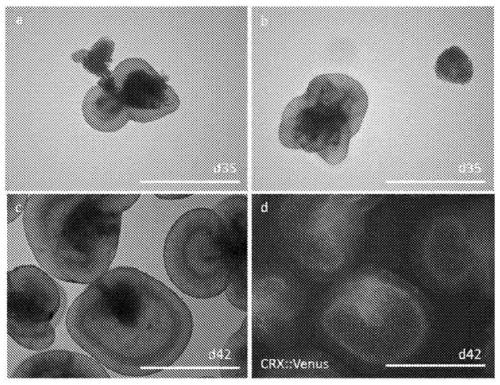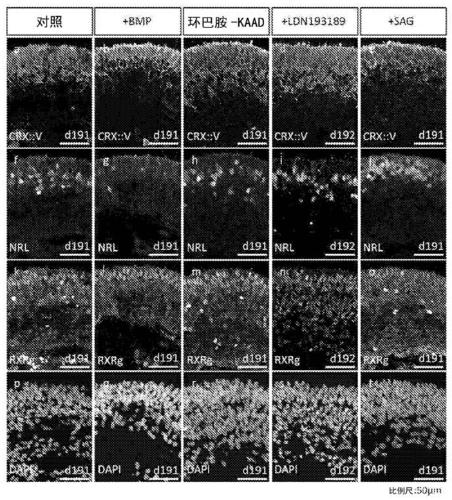Method for amplifying cone photoreceptors or rod photoreceptors by using dorsalization signal transmitter or ventralization signal transmitter
A technology of cone cells and rod cells, applied in the field of retinal tissue
- Summary
- Abstract
- Description
- Claims
- Application Information
AI Technical Summary
Problems solved by technology
Method used
Image
Examples
preparation example Construction
[0123]Preparation of target vectors for homologous recombination target genes and efficient sorting of homologous recombination can be carried out according to the following methods: Gene Targeting, A Practical Approach (gene targeting, practical method), IRLPress at Oxford University Press (1993); Biomanual Series 8, Gene Targeting, Making of Mutant Mouse using ES cell (gene targeting, using ES cells to produce mutant mice), YODOSHA CO., LTD. (1995); etc. Either a substitution type or an insertion type can be used for the targeting vector. As a sorting method, methods such as positive selection, promoter selection, negative selection, and polyadenylic acid (polyA) selection can be used.
[0124] As a method for selecting a desired homologous recombinant from the sorted cell lines, DNA hybridization method (Southern hybridization method) to genomic DNA, PCR method, etc. are mentioned.
[0125] The "suspension culture" or "suspension culture method" in the present invention re...
Embodiment 1
[0653] Example 1 (Preparation of Cell Aggregates Containing Retinal Tissue Using Human ES Cells and Excision Method of Retinal Tissue)
[0654] Human ES cells (derived from KhES-1; Nakano, T. et al. Cell Stem cell2012, 10(6), 771-785) knocked into CRX::Venus were based on Ueno, m. et al. PNAS 2006, 103 (25), 9554-9559" and "Watanabe, K. et al. Nat Biotech 2007, 25, 681-686". As for the culture medium for human ES cells, DMEM / F12 20% KSR (Knockout TM Serum replacement; Invitrogen), 0.1 mM 2-mercaptoethanol, 2 mM L-glutamine, 1x non-essential amino acids, 7.5 ng / mL bFGF medium.
[0655] Cell aggregates including retinal tissue were prepared by modifying a part of the method described in "Kuwahara et al. Nat Commun 2015, 19(6), 6286-". That is, after the previously cultured ES cells were dispersed into individual cells using TrypLE Express (Invitrogen), the individual dispersed human ES cells were separated into 9×10 cells per well. 3 Cells were suspended in 100 μL of serum-fr...
Embodiment 2
[0661] In the method described in Example 1, a dorsalization signal transduction substance (BMP4 or cyclopamine-KAAD) or a ventralization signal transduction substance (LDN193189 or SAG) was added as follows to prepare a retinoid-rich Aggregates of retinal tissue of cone or rod precursor cells.
[0662] [1] Control group ( figure 2 a, f, k, p); According to the method described in Example 1, culture was carried out without adding any substance until the 70th or 75th day after the start of the suspension culture.
[0663] [2]+BMP group ( figure 2 b, g, l, q); From the 22nd day to the end of the suspension culture, 0.15nM BMP4 was added, and cultured to the 70th day or the 75th day after the suspension culture was started.
[0664] [3]+Cyclopamine-KAAD group ( figure 2 c, h, m, r); from the 22nd day to the end of the suspension culture, 500 nM cyclopamine-KAAD was added, and cultured to the 70th or 75th day after the suspension culture started.
[0665] [4]+LDN193189 grou...
PUM
| Property | Measurement | Unit |
|---|---|---|
| Diameter | aaaaa | aaaaa |
Abstract
Description
Claims
Application Information
 Login to View More
Login to View More - R&D
- Intellectual Property
- Life Sciences
- Materials
- Tech Scout
- Unparalleled Data Quality
- Higher Quality Content
- 60% Fewer Hallucinations
Browse by: Latest US Patents, China's latest patents, Technical Efficacy Thesaurus, Application Domain, Technology Topic, Popular Technical Reports.
© 2025 PatSnap. All rights reserved.Legal|Privacy policy|Modern Slavery Act Transparency Statement|Sitemap|About US| Contact US: help@patsnap.com



